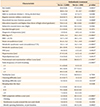1. Yun KI, Chae CH, Lee CW. Effect of estrogen on the expression of cytokines of the temporomandibular joint cartilage cells of the mouse. J Oral Maxillofac Surg. 2008; 66:882–887.

2. Tanaka MMY, Jóias RM, Jóias RP, Josgrilberg EB, de Mello Rode S. Evaluation of TMD signals and symptoms in individuals undergoing orthodontic treatment. Braz Dent Sci. 2016; 19:70–75.

3. Egermark I, Magnusson T, Carlsson GE. A 20-year follow-up of signs and symptoms of temporomandibular disorders and malocclusions in subjects with and without orthodontic treatment in childhood. Angle Orthod. 2003; 73:109–115.
4. McNamara JA Jr, Seligman DA, Okeson JP. Occlusion, orthodontic treatment, and temporomandibular disorders: a review. J Orofac Pain. 1995; 9:73–90.
5. Hwang SH, Park SG. Experience of orthodontic treatment and symptoms of temporomandibular joint in South Korean adults. Iran J Public Health. 2018; 47:13–17.
6. Fernández-González FJ, Cañigral A, López-Caballo JL, Brizuela A, Moreno-Hay I, Del Río-Highsmith J, et al. Influence of orthodontic treatment on temporomandibular disorders. A systematic review. J Clin Exp Dent. 2015; 7:e320–e327.

7. Steenks MH, Türp JC, de Wijer A. Reliability and validity of the Diagnostic Criteria for Temporomandibular Disorders Axis I in clinical and research settings: a critical appraisal. J Oral Facial Pain Headache. 2018; 32:7–18.

8. Schiffman E, Ohrbach R. Executive summary of the Diagnostic Criteria for Temporomandibular Disorders for clinical and research applications. J Am Dent Assoc. 2016; 147:438–445.

9. Magnusson T, Egermark I, Carlsson GE. A longitudinal epidemiologic study of signs and symptoms of temporomandibular disorders from 15 to 35 years of age. J Orofac Pain. 2000; 14:310–319.
10. Carlsson GE, Egermark I, Magnusson T. Predictors of signs and symptoms of temporomandibular disorders: a 20-year follow-up study from childhood to adulthood. Acta Odontol Scand. 2002; 60:180–185.

11. Runge ME, Sadowsky C, Sakols EI, BeGole EA. The relationship between temporomandibular joint sounds and malocclusion. Am J Orthod Dentofacial Orthop. 1989; 96:36–42.

12. Kim TW, Byun ES, Baek SH, Chang YI, Nahm DS, Yang WS. MRI study of temporomandibular joint disorder in orthodontic patients. Korean J Orthod. 2000; 30:235–243.
13. Henrikson T, Nilner M, Kurol J. Signs of temporomandibular disorders in girls receiving orthodontic treatment. A prospective and longitudinal comparison with untreated Class II malocclusions and normal occlusion subjects. Eur J Orthod. 2000; 22:271–281.

14. Sadowsky C, Polson AM. Temporomandibular disorders and functional occlusion after orthodontic treatment: results of two long-term studies. Am J Orthod. 1984; 86:386–390.

15. Rendell JK, Norton LA, Gay T. Orthodontic treatment and temporomandibular joint disorders. Am J Orthod Dentofacial Orthop. 1992; 101:84–87.

16. Sato S, Kawamura H, Nagasaka H, Motegi K. The natural course of anterior disc displacement without reduction in the temporomandibular joint: follow-up at 6, 12, and 18 months. J Oral Maxillofac Surg. 1997; 55:234–238. discussion 238-9.

17. Kurita K, Westesson PL, Yuasa H, Toyama M, Machida J, Ogi N. Natural course of untreated symptomatic temporomandibular joint disc displacement without reduction. J Dent Res. 1998; 77:361–365.

18. Egermark I, Carlsson GE, Magnusson T. A 20-year longitudinal study of subjective symptoms of temporomandibular disorders from childhood to adulthood. Acta Odontol Scand. 2001; 59:40–48.

19. Magnusson T, Carlsson GE, Egermark I. Changes in subjective symptoms of craniomandibular disorders in children and adolescents during a 10-year period. J Orofac Pain. 1993; 7:76–82.
20. Könönen M, Waltimo A, Nyström M. Does clicking in adolescence lead to painful temporomandibular joint locking? Lancet. 1996; 347:1080–1081.

21. Kamisaka M, Yatani H, Kuboki T, Matsuka Y, Minakuchi H. Four-year longitudinal course of TMD symptoms in an adult population and the estimation of risk factors in relation to symptoms. J Orofac Pain. 2000; 14:224–232.
22. Randow K, Carlsson K, Edlund J, Oberg T. The effect of an occlusal interference on the masticatory system. An experimental investigation. Odontol Revy. 1976; 27:245–256.
23. Egermark-Eriksson I, Carlsson GE, Magnusson T. A long-term epidemiologic study of the relationship between occlusal factors and mandibular dysfunction in children and adolescents. J Dent Res. 1987; 66:67–71.

24. Riise C, Sheikholeslam A. The influence of experimental interfering occlusal contacts on the postural activity of the anterior temporal and masseter muscles in young adults. J Oral Rehabil. 1982; 9:419–425.

25. Le Bell Y, Jämsä T, Korri S, Niemi PM, Alanen P. Effect of artificial occlusal interferences depends on previous experience of temporomandibular disorders. Acta Odontol Scand. 2002; 60:219–222.

26. Michelotti A, Farella M, Gallo LM, Veltri A, Palla S, Martina R. Effect of occlusal interference on habitual activity of human masseter. J Dent Res. 2005; 84:644–648.

27. Le Bell Y, Niemi PM, Jämsä T, Kylmälä M, Alanen P. Subjective reactions to intervention with artificial interferences in subjects with and without a history of temporomandibular disorders. Acta Odontol Scand. 2006; 64:59–63.

28. Schiffman E, Ohrbach R, Truelove E, Look J, Anderson G, Goulet JP, et al. Diagnostic Criteria for Temporomandibular Disorders (DC/TMD) for clinical and research applications: recommendations of the International RDC/TMD Consortium Network
* and Orofacial Pain Special Interest Group
†. J Oral Facial Pain Headache. 2014; 28:6–27.

29. Egermark I, Carlsson GE, Magnusson T. A prospective long-term study of signs and symptoms of temporomandibular disorders in patients who received orthodontic treatment in childhood. Angle Orthod. 2005; 75:645–650.
30. Bourzgui F, Sebbar M, Nadour A, Hamza M. Prevalence of temporomandibular dysfunction in orthodontic treatment. Int Orthod. 2010; 8:386–398.







 PDF
PDF ePub
ePub Citation
Citation Print
Print



 XML Download
XML Download